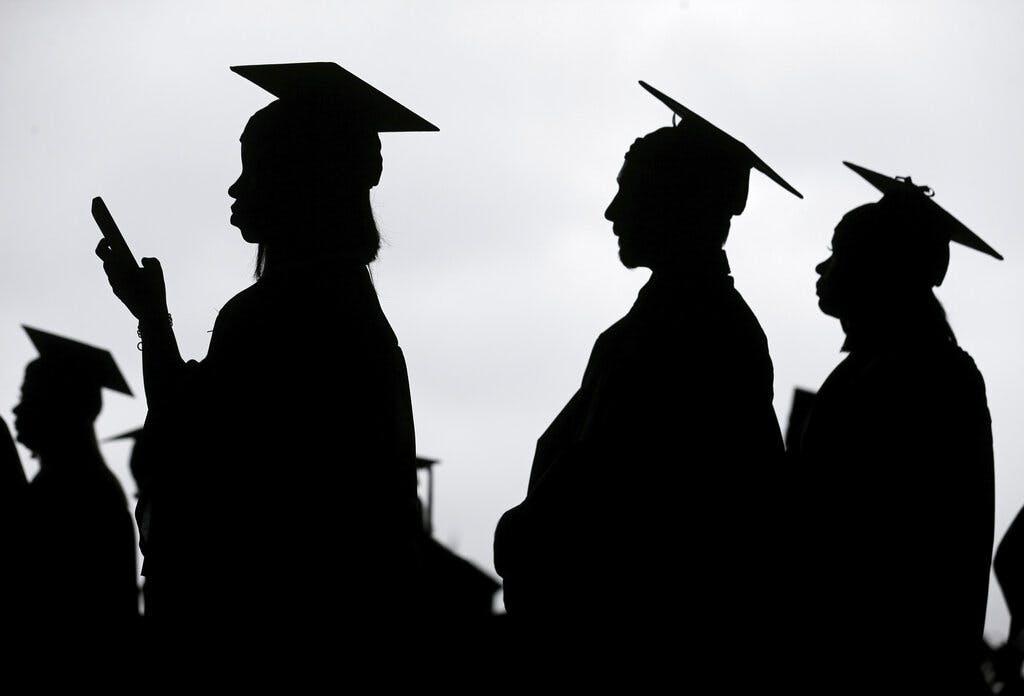Biden Student Loan Plan Will Encourage More Borrowing, Drive up Tuition
Get 50 percent off the cost of college, but only if you pay with a federal loan, because you don’t have to pay it all back.

A new analysis of President Biden’s proposed changes to federal student loan programs by a leading progressive think tank suggests that the initiatives will encourage more student borrowing, push up college tuition, subsidize low-paying degrees, and primarily benefit upper-income families.
The report, by Adam Looney of the Brookings Institution, says Mr. Biden’s plan to change income-driven payment programs — under which borrowers pay a portion of their take-home pay for a set period, after which the loan is forgiven — will cost far more than existing financial aid programs and lead to almost certain fraud and abuse of the program.
Mr. Biden proposed the changes in conjunction with a plan to forgive as much as $10,000 — $20,000 in the case of low-income borrowers — for the 40 million Americans sitting on roughly half a trillion dollars in outstanding student debt. Polls show that a majority of Americans support the move, but budget hawks have howled about the proposal’s $400 million to $600 million price tag and its propensity to direct working-class taxpayers’ money to well-off students headed into lucrative white-collar careers.
“In the absence of action from Congress, Biden has no other obvious policy levers to reduce college costs,” Mr. Looney writes. “But using government loans to subsidize college has important disadvantages and will lead to unintended and unfortunate consequences for borrowing, student outcomes, higher education costs, equity, and the federal budget.”
Mr. Biden’s Education Department has said it wants to revamp an existing income-based payment program in ways that would make it far more generous than existing ones. Undergraduate borrowers would be asked to pay five percent of their income above about $33,000 for 20 years — 10 years in the case of public sector workers. At the end of the period, all outstanding loans would be forgiven regardless of how much the student borrowed.
If the new rules, which are subject to public comment, take effect as scheduled in January 2023 “loans will be the preferred option for most students, and by a wide margin. Get 50 percent off the cost of college! But only if you pay with a federal loan, because you don’t have to pay it all back,” the Brookings analysis says.
Among other unintended consequences of the changes, Mr. Looney says the program would subsidize low-quality, low-earning degrees at the expense of more valuable degrees. Existing guardrails that lock out schools where large numbers of students default on their loans would be gutted, and all eligible students would be automatically enrolled in the new program.
“Want a free ride to college? You can have one, but only if you study cosmetology, liberal arts, or drama, preferably at a for-profit school,” Mr. Looney said. “Want to be a nurse, an engineer, or major in computer science or math? You’ll have to pay full price (especially at the best programs in each field).”
There also exists a high potential for abuse and fraud in the new program, Mr. Looney said. Students would be encouraged to borrow more than what they pay for tuition and be able to pocket the difference for living expenses and other incidentals. “Some people will use loans like an ATM, which will be costly for taxpayers and is certainly not the intended use of the loans,” he says.
The program would also be highly regressive, Mr. Looney says, benefiting white, well-educated students from upper-income families far more than lower-income students. A single graduate student would be able to borrow $20,000 a year just for living expenses and never pay it back. A single mother with two children is currently eligible for about $12,400 in annual benefits via the Earned Income Tax Credit and food stamps programs.
“College tuition for low-income and most middle-income families is already largely covered by other federal, state and private aid; why is the government making it a priority to spend more to cover the cost of expensive colleges, graduate programs, and living expenses for upper-middle-class families instead of on policies that serve the truly disadvantaged?” Mr Looney writes.
Finally, Mr. Looney also argues that these unrestricted tuition subsidies will encourage colleges and universities — especially for-profit ones — to raise tuition. Schools will have little incentive to keep costs low if students are able to borrow as much as they want, and, in fact, would “have an incentive to create valueless programs and aggressively recruit students into those programs with promises they will be free under an IDR plan.”
According to some projections, Mr. Biden’s promise to cancel $10,000 of everyone’s student debt will cost American taxpayers between $469 billion and $519 billion over the next 10 years. The proposed changes to the income repayment program, however, could bring the total cost of the initiative to more than $1 trillion over the same period.

